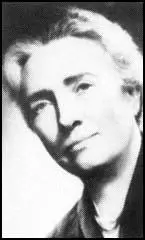Anna Kethly

Anna Kethly was born in Hungary in 1889. She found work as a clerk and became an active trade unionist. A member Social Democratic Party she was elected to Parliament after the First World War. Kethly was one of those in the Social Democratic Party who favoured working with the Communist Party.
The Soviet Army invaded Hungary in September 1944. It set up an alternative government in Debrecen on 21st December 1944 but did not capture Budapest until 18th January 1945. Soon afterwards Zoltan Tildy became the provisional prime minister.
In elections held in November, 1945, the Smallholders Party won 57% of the vote. The Hungarian Workers Party, now under the leadership of Matyas Rakosi and Erno Gero, received support from only 17% of the population. The Soviet commander in Hungary, Marshal Voroshilov, refused to allow the Smallholders to form a government. Instead Voroshilov established a coalition government with the communists holding all the key posts. Kovacs became minister of agriculture (1945-46).
The Hungarian Communist Party became the largest single party in the elections in 1947 and served in the coalition People's Independence Front government. The communists gradually gained control of the government and by 1948 opposition politicians such as Kethly had been imprisoned.
Matyas Rakosi also demanded complete obedience from fellow members of the Hungarian Workers Party. When Laszlo Rajk, the foreign secretary, criticised attempts by Joseph Stalin to impose Stalinist policies on Hungary he was arrested and in September 1949 he was executed. Janos Kadar and other dissidents were also purged from the party during this period.
Rakosi now attempted to impose authoritarian rule on Hungary. An estimated 2,000 people were executed and over 100,000 were imprisoned. These policies were opposed by some members of the Hungarian Workers Party and around 200,000 were expelled by Rakosi from the organization.
The Hungarian Uprising began on 23rd October by a peaceful manifestation of students in Budapest. The students demanded an end to Soviet occupation and the implementation of "true socialism". The following day commissioned officers and soldiers joined the students on the streets of Budapest. Stalin's statue was brought down and the protesters chanted "Russians go home", "Away with Gero" and "Long Live Nagy".
On 25th October Soviet tanks opened fire on protesters in Parliament Square. One journalist at the scene saw 12 dead bodies and estimated that 170 had been wounded. Shocked by these events the Central Committee of the Communist Party forced Erno Gero to resign from office and replaced him with Janos Kadar.
Imre Nagy now went on Radio Kossuth and promised the "the far-reaching democratization of Hungarian public life, the realisation of a Hungarian road to socialism in accord with our own national characteristics, and the realisation of our lofty national aim: the radical improvement of the workers' living conditions."
On 3rd November, Nagy announced details of his coalition government. It included Kethly, Janos Kadar, George Lukacs, Geza Lodonczy, Zolton Tildy, Bela Kovacs, Istvan Szabo, Gyula Keleman, Joseph Fischer, Istvan Bibo and Ferenc Farkas.
On 4th November 1956 Nikita Khrushchev sent the Red Army into Hungary and Nagy's government was overthrown. Kethly went into exile and in 1957 became head of the Hungarian Revolutionary Council in Strassbourg.
Anna Kethly died in 1976.
